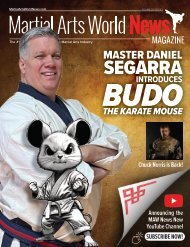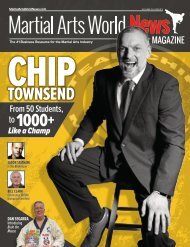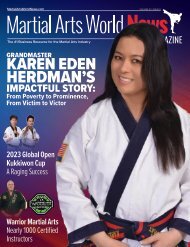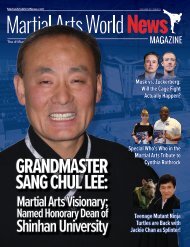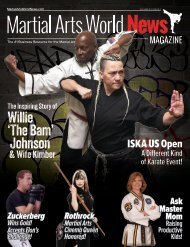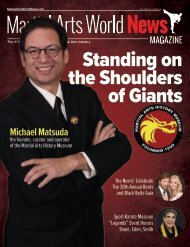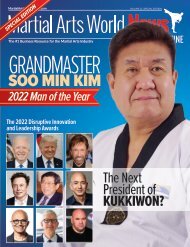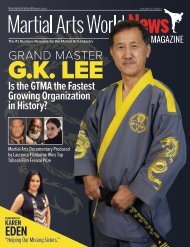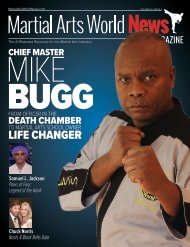Martial Arts World News Magazine - Volume 22 | Issue 2
The #1 Business Resource for the Martial Arts Industry
The #1 Business Resource for the Martial Arts Industry
Create successful ePaper yourself
Turn your PDF publications into a flip-book with our unique Google optimized e-Paper software.
INSTRUCTIONAL EXCELLENCE<br />
The Value of Forms<br />
By Grandmaster Tim McCarthy<br />
There are some who say the ultimate way to judge a martial arts technique is its selfdefense<br />
or street application. I respectfully disagree.<br />
Why? Because, to me, self-defense is only one aspect of the<br />
martial arts. In my martial arts, the best self-defense is NOT fighting.<br />
If I have to fight, I fight to win…but if I can avoid a fight with<br />
patience and cooperation, I think that’s a much more valuable skill.<br />
Of course, it all depends on your goals. If you have an MMA<br />
gym whose goal is to produce successful ring fighters, then the<br />
practical application of ring results is the ultimate judge of your<br />
success. On the other hand, if you have a family martial arts school<br />
where building confidence and respect are more useful to your<br />
students in their everyday lives than high kicks and<br />
submission holds, then the practical application<br />
becomes something entirely different.<br />
I consider myself a martial artist, not a fighter.<br />
I enjoy the art more than the martial. I haven’t<br />
been in a street fight in over 45 years, and even<br />
then it wasn’t much of a fight. If I spent those last<br />
45 years training only for street effectiveness,<br />
I would’ve wasted a lot of time. However, in my<br />
training, I developed strength, flexibility, balance,<br />
endurance, and self-control by practicing forms. I<br />
enjoyed my art like a dancer enjoys dancing,<br />
and pursued perfection in my expression.<br />
That pursuit led to the development<br />
of dedication, concentration, and<br />
indomitable spirit that bled over<br />
into other areas of my life, including<br />
huge dividends in health and<br />
fitness over the years. I’m not<br />
sure I would’ve gained all those<br />
“outside the ring” benefits had<br />
I only focused on fighting, and<br />
probably would’ve sustained<br />
a lot more injuries.<br />
I understand that what<br />
works for me may not work<br />
for you—we’re all different with different needs. My question to you<br />
is what are your students’ needs? Do they need to be the best street<br />
fighters in the city, or do they need to learn discipline, respect, confidence,<br />
and indomitable spirit? If your students are like mine, they’re<br />
in the second group, and the traditions of the martial arts are just as<br />
important as the effectiveness of the techniques—maybe more so.<br />
Some forms’ training actually does teach valuable self-defense<br />
techniques. I’ve heard that the older forms disguised the techniques<br />
because they were so deadly that students were only<br />
taught the true application after many years of study and achievement<br />
of sufficient rank. Some forms even disguised the techniques<br />
by separating them by one or two moves, so that what appears to<br />
be a series of blocks was actually a throw. Perhaps that’s why the<br />
techniques don’t always make sense to someone who thinks they<br />
know more than they actually do. To me, the martial arts are not<br />
about fighting, but about self-improvement using techniques that<br />
also have a self-defense application. Sparring is valuable because<br />
it helps reveal weaknesses in my techniques and improves my<br />
spirit of competition, but it’s only one aspect of a complete program.<br />
I would rather spend the bulk of my time focusing on how to<br />
make myself better through forms practice than on how to defeat<br />
someone else through sparring.<br />
I believe in the traditions of bowing and treating each other with<br />
respect because the attitude also works outside the ring. I believe<br />
the discipline in one-step sparring helps not only teach technique,<br />
but teach children to take turns, cooperate, and control both their<br />
gross and fine motor skills. I believe breaking teaches undeniable<br />
lessons about the power of our techniques. I believe forms practice<br />
is an artistic expression that challenges us in the relentless<br />
pursuit of perfection.<br />
In short, I believe in a complete martial arts program that has<br />
proven effective for generations over the opinion fighters who<br />
say their area of expertise is the only one that counts. If that line<br />
of reasoning were accurate, shouldn’t Mike Tyson have become<br />
president of the United States…or at least secretary of education?<br />
GRANDMASTER TIM MCCARTHY is a 9th degree black belt and is a martial arts educator<br />
with a master’s degree in education. He has been instrumental in developing two industry-changing<br />
programs, plus has directed and been featured in hundreds of martial arts videos and webinars.<br />
92 MARTIAL ARTS WORLD NEWS VOLUME <strong>22</strong> | ISSUE 2



